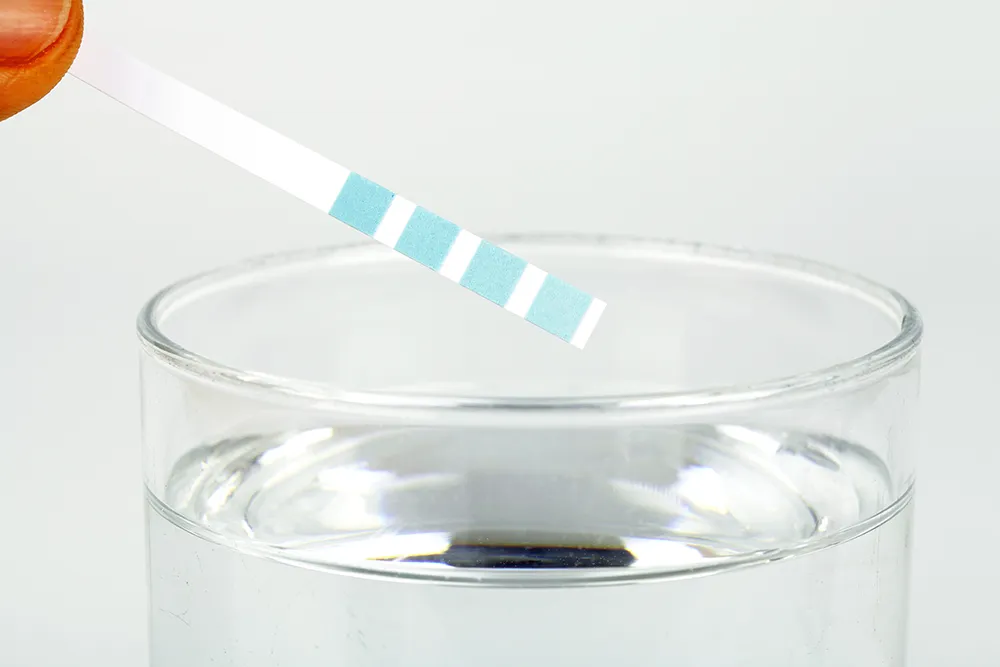What is water hardness?
The hardness of water is determined by its dissolved calcium and magnesium content. Colloquially, this is referred to as lime content. Calcium carbonate is the primary hardness-forming substance. Magnesium compounds comprise a much smaller proportion of the water hardness (approx. 15 – 30 %).
How does water hardness arise?
Through leaching and dissolution, magnesium and calcium ions from the soil reach the deeper groundwater layers. The respective geological subsoil determines the distribution of the hardness constituents. For this reason, the concentration can vary significantly from region to region. Areas with limestone or gypsum-bearing strata supply harder water. So-called acid rain and lime fertilisation are further causes of the increase in the hardness range of groundwater. Rainwater, by the way, has a value in the zero sectors and is thus very soft.
Classification into degrees of water hardness
The UK waterworks indicate the degrees of hardness as soft, medium and hard
- Soft water: Less than 50 milligrams of calcium carbonate per litre (mg/l).
- Moderately soft water: Between 50 and 100 mg/l calcium carbonate.
- Moderately hard water: Between 100 and 200 mg/l calcium carbonate.
- Hard water: Over 200 mg/l calcium carbonate.
Significance of the degrees of hardness
To begin with: even a high calcium content in drinking water and thus a high degree of hardness does not pose a health hazard. This is because calcium is an essential element for the organism; it serves as a building material for bones and teeth. The Drinking Water Ordinance does not set any limit values for the hardness of drinking water. The hardness ranges are essential for the trouble-free operation and handling of technical systems, installations and appliances.
Hard tap water can cause the calcification of many household appliances if it is not adequately maintained. Stubborn deposits form mainly due to heating, for example, during washing. Formerly also known as scale. The consumption of detergents depends on the degree of hardness because they already contain softeners. The detergent manufacturer’s dosage instructions should therefore be followed to protect the washing machine and for optimal laundry care.
The taste of hard water is not a health hazard but unpleasant. It diminishes the enjoyment of coffee and tea and is detrimental to the preparation of some dishes. The use of water filters is a possible alternative. Soft tap water is better for cooking and washing. Hot drinks taste more aromatic. However, it is unfavourable that soap is more difficult to remove when washing hands and detergents foam more. Houseplants love soft water because it is closest to natural rainwater.
Avoiding damage from hard water
Limescale precipitates in hot water as a white coating is clearly visible on kettles or taps. Less visible are the destructive limescale layers in irons, washing machines and hot water boilers. Encrusted heating elements lead to heat accumulation or even failure of the heating power. Fragile components such as valves, seals, strainers and rubber pipes can also be badly affected in coffee machines. Unnecessarily expensive repairs can be prevented – regular descaling of washing machines, dishwashers, kettles and coffee machines is, therefore, a must. Proven household remedies for small appliances are vinegar or citric acid.
Domestic installations are particularly at risk from creeping limescale deposits. The only remedy is constant monitoring or the installation of a descaling system. It works on the principle of ion exchange. In galvanised boilers and enamelled boilers, sacrificial anode systems prevent unwanted crystallisation. Filter cartridges or pads should generally be changed regularly in water treatment systems.
How to test your water for water hardness?
Water hardness can vary significantly across a region. Although the water supply companies usually mix the water homogeneously from different catchment areas, the fundamental character of a geographically determined water quality remains.
Suppose you have not noticed any sensory abnormalities in your drinking water. In that case, you can be absolutely sure with a water test. A drinking water analysis will show you whether your water arrives in perfect food quality. The water test is easy to take. After sending the sample to a recognised laboratory, you will receive a detailed breakdown of the quality of your water after a short time.

